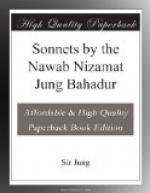But despite the continued vogue of the Sonnet, and its association with the names of such masters as Dante, Petrarch, Tasso and Michelangelo in Italy; Ronsard in France; Camoens in Portugal; Shakespeare, Milton, Wordsworth and Rossetti in England—to say nothing of a host of minor poets, who, though one star differeth from another in glory, yet constitute a brilliant galaxy—it is remarkable that even now the average non-literary reader when asked “What is a Sonnet?” seldom gives any more explicit reply than to say it is “a short poem limited to fourteen lines.”
The rules for the structure of those fourteen lines, and the labour and patience entailed in producing a poem under these limitations, are not always realised even by those who enjoy the results of the poet’s concentrated efforts. The more successful a sonnet, the more the reader is apt to accept its beauty as if it had grown by a natural process like a flower. This, perhaps, is the best compliment we could pay the poet; but if the poet is one who boldly essays a most difficult and complex form, in a language which for him is foreign, then we should pause a moment to consider what it is that he has set out to accomplish.
Taking the structure first (though for the poet the spirit and impetus of the central idea must of course come first)—a sonnet on the Italian (Petrarchan) model must consist of fourteen lines of ten syllables each, and must be composed of a major and minor system, i.e. an octave and a sestet.
In the octave (the first eight lines) the first, fourth, fifth and eighth lines must rhyme on the same sound, and the second, third, sixth and seventh, must rhyme on another sound.
In the sestet (the last six lines) more liberty of rhyme and arrangement is permitted, but a rhymed couplet at the end is not usual except when the sonnet departs from the Italian model and is on the English or, as we say, “Shakespearian” pattern.
Each sonnet must be complete; and, even if one of a sequence, it should contain within itself everything necessary to the understanding of it. It must be the expression of one emotion, one fact, one idea, and “the continuity of the thought, idea, or emotion must be unbroken throughout.” “Dignity and repose,” “expression ample yet reticent,” are qualities which one of our ablest modern critics emphasises as essential, and the end must always be more impressive than the beginning,—the reader must be carried onwards and upwards, and left with a definite feeling that in what has been said there is neither superfluity nor omission, but rather a completeness which precludes all wish or need for a longer poem.
How difficult this is for the poet can only be realised by trying to achieve it.
The earliest writers of English sonnets were two very romantic and gallant men of action, Sir Thomas Wyatt, and Henry Howard, Earl of Surrey,—both destined to brief brilliant lives and tragic deaths. They were followed by Spenser, Sir Philip Sidney and a host of Elizabethan poets, courtly and otherwise. But it is Shakespeare whose Sonnets (though not conforming to the Petrarchan model) show the most force and fire of any in our language until those of Milton.




